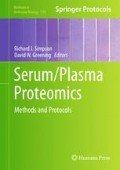Abstract
Profiling of serum and plasma proteins has substantial relevance to the discovery of circulating disease biomarkers. However, the extreme complexity and vast dynamic range of protein abundance in serum and plasma present a formidable challenge for protein analysis. Thus, integration of multiple technologies is required to achieve high-resolution and high-sensitivity proteomic analysis of serum or plasma. In this chapter, we describe an orthogonal multidimensional intact-protein analysis system (IPAS) (Wang et al., Mol Cell Proteomics 4:618–625, 2005) coupled with protein tagging (Faca et al., J Proteome Res 5:2009–2018, 2006) to profile the serum and plasma proteomes quantitatively, which we have applied in our biomarker discovery studies (Katayama et al., Genome Med 1:47, 2009; Faca et al., PLoS Med 5:e123, 2008; Zhang et al. Genome Biol 9:R93, 2008).
Access this chapter
Tax calculation will be finalised at checkout
Purchases are for personal use only
References
Zhang Q., menon R., Deutsch E.W. et al. (2008). A mouse plasma peptide atlas as a resource for disease proteomics. Crenome Biol. 9, R93.
Klose, J. (1975). Protein mapping by combined isoelectric focusing and electrophoresis of mouse tissues. A novel approach to testing for induced point mutations in mammals. Hum. Genet. 26, 231–243.
O’Farrell, P. H. (1975). High resolution two-dimensional electrophoresis of proteins. J. Biol. Chem. 250, 4007–4021.
Hanash, S. M. (2000). Biomedical applications of two-dimensional electrophoresis using immobilized pH gradients: Current status. Electrophoresis. 21, 1202–1209.
Wang, H., Clouthier, S.G., Galchev, V. et al. (2005). Intact-protein-based high-resolution three-dimensional quantitative analysis system for proteome profiling of biological fluids. Mol Cell Proteomics. 4, 618–625.
Stasyk, T., Huber, L. A. (2004). Zooming in: Fractionation strategies in proteomics. Proteomics. 4, 3704–3716.
Betgovargez, E., Knudson, V., Simonian, M. H. (2005). Characterization of Proteins in the Human Serum Proteome. J Biomol Tech. 16, 306–310.
Sheng, S., Chen, D., Van Eyk, J. E. (2006). Multidimensional liquid chromatography separation of intact proteins by chromatographic focusing and reversed phase of the human serum proteome: optimization and protein database. Mol Cell Proteomics. 5, 26–34.
Ke, C. Y., Geng, X. D. (2008). A new chromatographic method for fast separation of active proteins. Chinese Science Bulletin. 53, 1113–1116.
Dugo, P., Cacciola, F., Kumm, T., Dugo, G., Mondello, L. (2008). Comprehensive multidimensional liquid chromatography: theory and applications. J Chromatogr A. 1184, 353–368.
Katayama, H., Paczesny, S., Prentice, R. et al. (2009). Application of serum proteomics to the Women’s Health Initiative conjugated equine estrogens trial reveals a multitude of effects relevant to clinical findings. Genome Med. 1, 47.
Faca, V.M., Song, K. S., Wang, H. et al. (2008). A mouse to human search for plasma proteome changes associated with pancreatic tumor development. PLoS Med. 5, e123.
Pitteri, S.J., JeBailey, L., Faça, V. M. et al. (2009). Integrated proteomic analysis of human cancer cells and plasma from tumor bearing mice for ovarian cancer biomarker discovery. PLoS One. 4, e7916.
Pitteri, S.J., Faca, V. M., Kelly-Spratt, K. S. et al. (2008). Plasma proteome profiling of a mouse model of breast cancer identifies a set of up-regulated proteins in common with human breast cancer cells. J Proteome Res. 7, 1481–1489.
Rauch, A., Bellew, M., Eng, J. et al. (2006). Computational Proteomics Analysis System (CPAS): an extensible, open-source analytic system for evaluating and publishing proteomic data and high throughput biological experiments. J Proteome Res. 5, 112–121.
Maclean, B., Eng, J. K., Beavis, R. C., McIntosh, M. (2006). General framework for developing and evaluating database scoring algorithms using the TANDEM search engine. Bioinformatics. 22, 2830–2832.
Nesvizhskii, A. I., Keller, A., Kolker, E. & Aebersold, R. (2003). A statistical model for identifying proteins by tandem mass spectrometry. Anal Chem 75, 4646–4658.
Faca, V., Coram, M., Phanstiel, D. et al. (2006). Quantitative analysis of acrylamide labeled serum proteins by LC-MS/MS. J Proteome Res. 5, 2009–2018.
Bradford, M. M. (1976). A rapid and sensitive method for the quantitation of microgram quantities of protein utilizing the principle of protein-dye binding. Anal. Biochem. 748, 248–254.
Keller, A., Nesvizhskii, A. I., Kolker, E., Aebersold, R. (2002). Empirical statistical model to estimate the accuracy of peptide identifications made by MS/MS and database search. Anal. Chem. 74, 5383–5392.
Kümin, A., Christine Huber, C., Thomas Rülicke, T., Wolf, E., Werner, E. (2006). Peroxiredoxin 6 Is a Potent Cytoprotective Enzyme in the Epidermis. Am J Pathol. 169, 1194–1205.
Chang, X. Z., Li, D. Q., Hou, Y. F. et al. (2007). Identification of the functional role of peroxiredoxin 6 in the progression of breast cancer. Breast Cancer Res. 9, R76.
Author information
Authors and Affiliations
Corresponding author
Editor information
Editors and Affiliations
Rights and permissions
Copyright information
© 2011 Springer Science+Business Media, LLC
About this protocol
Cite this protocol
Wang, H., Hanash, S. (2011). Intact-Protein Analysis System for Discovery of Serum-Based Disease Biomarkers. In: Simpson, R., Greening, D. (eds) Serum/Plasma Proteomics. Methods in Molecular Biology, vol 728. Humana Press. https://doi.org/10.1007/978-1-61779-068-3_4
Download citation
DOI: https://doi.org/10.1007/978-1-61779-068-3_4
Published:
Publisher Name: Humana Press
Print ISBN: 978-1-61779-067-6
Online ISBN: 978-1-61779-068-3
eBook Packages: Springer Protocols

